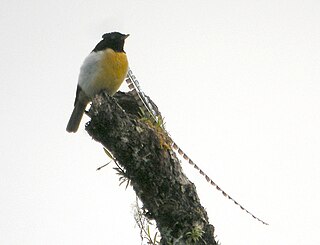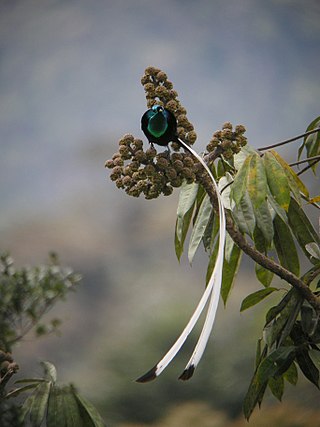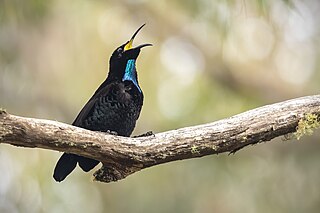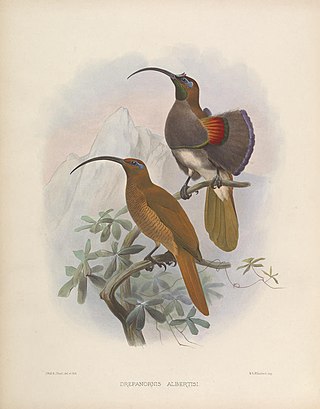
The birds-of-paradise are members of the family Paradisaeidae of the order Passeriformes. The majority of species are found in eastern Indonesia, Papua New Guinea, and eastern Australia. The family has 45 species in 17 genera. The members of this family are perhaps best known for the plumage of the males of the species, the majority of which are sexually dimorphic. The males of these species tend to have very long, elaborate feathers extending from the beak, wings, tail, or head. For the most part, they are confined to dense rainforest habitats. The diet of all species is dominated by fruit and to a lesser extent arthropods. The birds-of-paradise have a variety of breeding systems, ranging from monogamy to lek-type polygamy.

The blue bird-of-paradise is a large species of bird-of-paradise. It is the only species in the genus Paradisornis, but was previously included in the genus Paradisaea.

The Arfak astrapia is a species of astrapia, a group of birds found in the birds-of-paradise family Paradiseidae.

The King of Saxony bird-of-paradise is a bird in the bird-of-paradise family (Paradisaeidae). It is the only member of the genus Pteridophora. It is endemic to montane forest in New Guinea.

The king bird-of-paradise is a passerine bird of the Paradisaeidae (bird-of-paradise) family. It is considered by the IOC checklist to be the only member of the genus Cicinnurus, although the genus Diphyllodes is closely related and is subsumed under Cicinnurus by many other authorities.

Astrapia is a genus of birds-of-paradise. The genus contains five species, all endemic to New Guinea. The males have highly iridescent plumage and remarkably long tails. Females are duller and have shorter tails.

The black sicklebill is a large member of the birds of paradise family, Paradisaeidae. This species is found throughout most of central New Guinea and the Vogelkop region to the northwest in montane forests at altitudes from 1,800 to 2,150 m.

Epimachus is a genus of birds-of-paradise (Paradisaeidae) that includes two species, found in the highland forests of New Guinea. They are the largest members of the family. The common name "sicklebill" refers to their long, decurved, sickle-shaped bill.

Lophorina is a genus of birds in the birds-of-paradise family Paradisaeidae that are endemic to New Guinea, formerly containing a single species, but as of 2017, containing three species.

The magnificent bird-of-paradise is a species of bird-of-paradise. The magnificent bird-of-paradise is evaluated as Least Concern on the IUCN Red List of Threatened Species. They are listed in Appendix II of CITES.

The greater lophorina, also known as superb bird-of-paradise or greater superb bird-of-paradise, is a species of the Paradisaeidae (bird-of-paradise) family. It was considered the sole species in the genus until in 2017 it was recognised that there were three species.

The Raggiana bird-of-paradise, also known as Count Raggi's bird-of-paradise, is a large bird in the bird-of-paradise family Paradisaeidae.

Victoria's riflebird, also known as the lesser riflebird, Queen Victoria riflebird, Queen Victoria's riflebird, or Victoria riflebird, is a bird-of-paradise endemic to the Atherton Tableland region of northeastern Queensland, Australia where it resides year-round.

The Splendid astrapia is a species of Astrapia of the birds-of-paradise family, Paradisaeidae, and one of the least known and most elusive of its family and genus.

The paradise riflebird is a passerine bird of the family Paradisaeidae. It is one of four riflebird species in the genus Ptiloris. It is found in subtropical, temperate rainforests in eastern Australia. The species is sexually dimorphic; the male is black with iridescent blue-green patches, while the female is gray-brown and white.

The black-billed sicklebill, also known as the buff-tailed sicklebill, is a species of bird-of-paradise. It, along with its congener, are the only members of the genus Drepanornis.

The genus Ptiloris consists of four allopatric species of birds in the family Paradisaeidae. These birds of paradise are commonly known as riflebirds, so named for the likeness of their black velvety plumage to the uniform of the Rifle Brigade. Alternatively, the bird's cry is similar to a rifle being fired and hitting its target but a call like this is not commonly reported. They are distributed in the rainforests of New Guinea and Eastern Australia.

The growling riflebird, also known as the eastern riflebird, is a medium-sized passerine bird of the family Paradisaeidae.

The fawn-breasted tanager is a species of tanager with a blue head and yellow breast. It occurs in the Andes of northwestern Argentina, Bolivia, Colombia, Ecuador, Peru and Venezuela, as well as in the highlands of northeastern Argentina, south Brazil, Paraguay and Uruguay.

The frilled coquette is a species of hummingbird in the "coquettes", tribe Lesbiini of subfamily Lesbiinae. It is endemic to Brazil.























